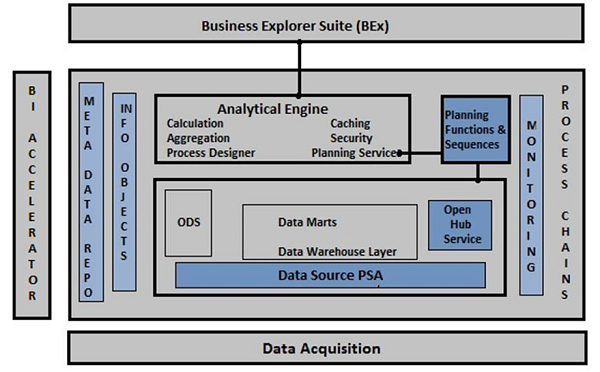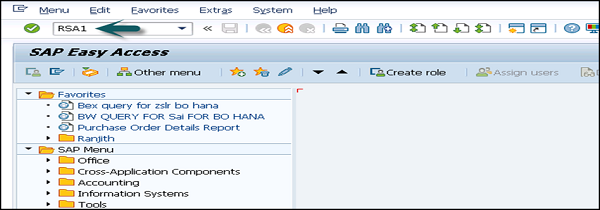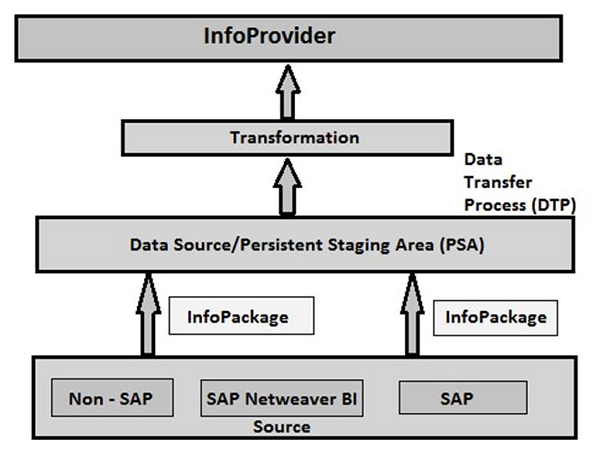
- SAP BW - Home
- SAP BW - Overview of SAP BI
- SAP BW - Data Warehousing
- SAP BW - Data Flow
- SAP BW - Transformation
- SAP BW - InfoArea, Object & Catalog
- SAP BW - DataStore Objects & Types
- SAP BW - Write Optimized DSO
- SAP BW - Infoset
- SAP BW - InfoCube
- SAP BW - Virtual InfoProvider
- SAP BW - MultiProvider
- SAP BW - Flat File Data Transfer
- SAP BW - DB Connect
- SAP BW - Universal Data Connect
- SAP BW - Process Chain
- SAP BW - Reporting
SAP BW - Overview of SAP BI
In this chapter, we will get to understand the basics of SAP BW and SAP BI. How it has evolved and improved over the years.
SAP BW and BI Introduction
SAP Business Intelligence (BI) means analyzing and reporting of data from different heterogeneous data sources. SAP Business Warehouse (BW) integrates data from different sources, transforms and consolidates the data, does data cleansing, and storing of data as well. It also includes data modeling, administration and staging area.
The data in SAP BW is managed with the help of a centralized tool known as SAP BI Administration Workbench. The BI platform provides infrastructure and functions which include −
- OLAP Processor
- Metadata Repository,
- Process designer and other functions.
The Business Explorer (BEx) is a reporting and analysis tool that supports query, analysis and reporting functions in BI. Using BEx, you can analyze historical and current data to different degree of analysis.
SAP BW is known as an open, standard tool which allows you to extract the data from different systems and then send it to the BI system. It also evaluates the data with different reporting tools and you can distribute this to other systems.
The following diagram shows an open, broad and standard based Architecture of Business Intelligence.

- BI stands for Business Intelligence
- BW stands for Business Warehouse
In 1997, SAP had first introduced a product for reporting, analysis and data warehousing and it was named as Business Warehouse Information System (BIW).
Later, the name was changed from SAP BIW to SAP Business Warehouse (BW). After SAP acquired Business Objects, the name of the product has been changed to SAP BI.
| Name | BIW Version | Release Date and Year |
|---|---|---|
| BIW | 1.2A | Oct 1998 |
| BIW | 1.2B | Sep 1999 |
| BIW | 2.0A | Feb 2000 |
| BIW | 2.0B | Jun 2000 |
| BIW | 2.1C | Nov 2000 |
| BW (Name changed to BW) | 3.0A | Oct 2001 |
| BW | 3.0B | May 2002 |
| BW | 3.1 | Nov 2002 |
| BW | 3.1C | Apr 2004 |
| BW | 3.3 | Apr 2004 |
| BW | 3.5 | Apr 2004 |
| BI (Name changed to BI) | 7 | Jul 2005 |
Data Acquisition in SAP BI
SAP BI allows you to acquire data from multiple data sources that can be distributed to different BI systems. A SAP Business Intelligence system can work as a target system for data transfer or source system for distribution of data to different BI targets.

As mentioned in the above image, you can see SAP BI source systems along with other systems −
- SAP systems (SAP Applications/SAP ECC)
- Relational Database (Oracle, SQL Server, etc.)
- Flat File (Excel, Notepad)
- Multidimensional Source systems (Universe using UDI connector)
- Web Services that transfer data to BI by means of push
When you go to SAP BI Administration workbench, the source system is defined there. Go to RSA1 → Source Systems


As per the data source type, you can differentiate between the source systems −
- Data Sources for transaction data
- Data Sources for master data
- Data Sources for hierarchies
- Data Sources for text
- Data Sources for attributes
You can load the data from any source in the data source structure into BI with an InfoPackage. Target system where the data is to be loaded is defined in the transformation.
InfoPackage
An InfoPackage is used to specify how and when to load data to the BI system from different data sources. An InfoPackage contains all the information on how the data is loaded from the source system to a data source or a PSA. InfoPackage consists of condition for requesting data from a source system.
Note − Using an InfoPackage in BW 3.5, you can load data in Persistence Staging Area and also in targets from source system, but If you are using SAP BI 7.0 the data load should be restricted to PSA only for latest versions.
BI Data Flow (InfoPackage and InfoProvider)

BI Content
BI objects consists of the following components −
- Roles
- Web templates and workbook
- Queries
- InfoProvider
- Update Rules
- InfoSource
- Transfer Rules
- InfoObjects
- DataSources
BI objects are divided into multiple BI content areas so that they can be used in an efficient way. This includes content area from all the key modules in an organization, which include −
- SCM
- CRM
- HR
- Finance Management
- Product Lifecycle
- Industry Solutions
- Non-SAP data sources, etc.